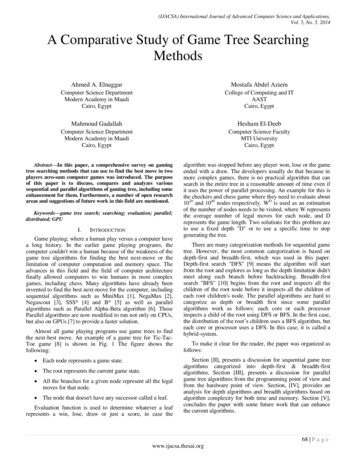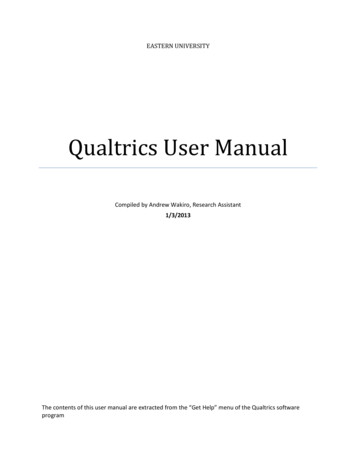
Transcription
Univ Access Inf Soc manuscript No.(will be inserted by the editor)Game Accessibility: a SurveyBei Yuan, Eelke Folmer, Frederick C. Harris, Jr.the date of receipt and acceptance should be inserted laterAbstract Over the last three decades, video gameshave evolved from a pastime into a force of change thatis transforming the way people perceive, learn about,and interact with the world around them. In additionto entertainment, games are increasingly used for otherpurposes such as education or health. Despite this increased interest, a significant number of people encounterbarriers when playing games, due to a disability. Accessibility problems may include: (1) not being able toreceive feedback; (2) not being able to determine ingame responses; (3) not being able to provide inputusing conventional input devices. This paper surveysthe current state-of-the-art in research and practice inthe accessibility of video games, and points out relevantareas for future research. A generalized game interaction model shows how a disability affects ones ability toplay games. Estimates are provided on the total number of people in the U.S. whose ability to play gamesis affected by a disability. A large number of accessiblegames are surveyed for different types of impairments,across several game genres, from which a number ofhigh- and low-level accessibility strategies are distilledfor game developers to inform their design.Keywords Game Accessibility, Disability, Strategy,Impairment1 IntroductionOver the past decades, video games have become amainstream form of entertainment, currently eclipsingDepartment of Computer Science and EngineeringUniversity of NevadaReno, NV 89557{bei, efolmer, fredh}@cse.unr.eduHollywood’s box office sales [105]. According to theNPD Group, currently more than 100 million consolesare present in U.S. households [62], and an estimated63% of the U.S. population plays video games, with51% of players playing games on at least a weekly basis [20]. An explanation for this popularity could bethat games provide something that other forms of entertainment, such as books, music, and movies, cannotprovide, i.e., interaction. Games are also increasinglyused for other purposes than entertainment. Educatorsare discovering the cognitive potential of games in theclassroom [84, 29, 45, 46] and games have also been usedfor health [87], religion [88] and politics [66]. Despitethe increased level of interest in games, a large groupof people find themselves excluded from playing videogames because of a disability [4, 6, 33].Software technology is often difficult to access forplayers with disabilities. In the past decades, considerable research efforts have been spent investigating howsoftware can be made accessible. As a result, many operating systems have accessibility features built in, suchas screen readers or support for keyboard shortcuts. Asnew technologies emerged, such as the Internet in the1990s, accessibility research efforts were directed to exploring how the world wide web and related technologies, such as email, could be made accessible, whichhas lead to the definition of the W3C Web Content Accessibility Guidelines (WCAG) [98]. These guidelinesprovide guidance on how to create web content that accommodates users with different types of impairments.These guidelines have successfully contributed to making the Internet more accessible.As the popularity of games increases, making gamesaccessible becomes more important. Still, little researchhas been conducted in this area. In certain circumstances, such as when games are used in the classroom
2for educational purposes, there may be a legal obligation to make them accessible, as Section 508 of the Rehabilitionat Act [93] states that schools and universitiesthat rely on federal funding must make their electronicand information technologies accessible.Games are fundamentally different from software,as their primary use is for entertainment. There havebeen two attempts at composing a set of game accessibility guidelines similar to the W3C web content guidelines [99]. The Independent Game Developers Association (IGDA) Special Interest Group (SIG) on GameAccessibility [42] published a white paper [41] in 2004that proposes 19 accessibility guidelines derived froma survey of 20 accessible games. The majority (16) ofthese games include games for the visually impaired,and a few (4) support motor or hearing impaired. TheNorwegian Medialt organization published a set of 34game accessibility guidelines [89] on their website, basedon the 19 IGDA game accessibility SIG guidelines aswell as their own set of guidelines. One of the problemswith guidelines is that they often assume an absolutevalidity, but in practice are only applicable in specificcontexts [97, 25]. For example, “provide subtitles” [41]is not applicable to a game without audio dialogs. “Allow for variable game speed” [89] is not applicable toturn-based games such as chess. Another problem withguidelines is that they do not provide an explanation ofwhat accessibility problem the guideline is supposed tosolve, making it difficult for a game developer to understand when and why the guideline can be applied. Theexisting game accessibility guidelines were published in2004 and were based on a limited number of accessible games for a small number of game genres. Sincethen, numerous accessible games have been developedfor game genres with more complex interaction models,as well as for game genres not included in the guidelines.This paper provides a comprehensive survey of thecurrent state-of-the-art of research and practice in gameaccessibility. The goals of this survey are: (1) to identify how a disability affects a player’s ability to playvideo games; (2) to identify the strategies for makinggames accessible; and (3) to identify areas for futureresearch. The remainder of this paper is organized asfollows: Section 2 introduces a generic interaction modelfor games, which is used to illustrate how a disabilityaffects the ability to play games. Estimates are provided for the number of people in the U.S. who cannotplay games due to a disability. Section 3 provides anoverview of existing accessible games and analyzes thedifferent strategies used in making them accessible. Section 4 summarizes and discusses the different strategiesthat have been identified and points out areas for futureresearch. Section 5 concludes the paper.2 Disabilities and GamesBefore introducing the game interaction model, thissection provides background information on disabilitiesand video games, as well as a consistent reference terminology.2.1 Video GamesVideo games come in different genres and more than 20genres have been identified [103, 43, 21]. Due to a generallack of commonly agreed-upon genres or criteria for thedefinition of game genres, the classification of games isnot always consistent, therefore, certain games may fitinto multiple categories. This survey takes into accountthe following eight seminal game genres:1. First-person Shooter (FPS) games are action gamesplayed from a first-person perspective that involvesshooting enemies with a range of different weapons.Popular examples include Doom, Quake, and Halo.2. Strategy games are combat games involving resourcemanagement and strategy. Players must build andmanage units that can be used to harvest resourcesor attack enemies. Some of these games are played inreal-time (RTS) while others are turn-based (TBS).Strategy games are played from a top-down perspective. Popular examples include Command and Conquer, Warcraft, and Civilization.3. Sports games simulate the playing of traditional sportssuch as tennis, football or soccer. Examples includeMadden and FIFA Soccer.4. Role-playing Games (RPG) involves playing a character that goes on quests and grows more powerfulalong the way. Examples include Neverwinter Nightsand World of Warcraft (WoW).5. Puzzle games test problem solving skills such aslogic, strategy, pattern recognition, and sequence/wordcompletion. Examples include Tetris and Bejewelled.6. Racing games emulate driving a car on a race tracksuch as Burnout Revenge, Project Gotham Racing,and Super Mario Karts.7. Dance/Rhythm games emulate the playing of or dancing to music through custom controllers such as Guitar Hero and Dance Dance Revolution.8. Adventure games are characterized by investigation,exploration, puzzle-solving, interaction with gamecharacters, and a focus on narrative rather thansensi-motor challenges. Popular adventure games include Myst and the Sam and Max series.Virtual worlds such as Second Life [1] have gained increasing popularity in recent years and allow their users
3to explore vast user generated environments using agame like third person interface. Though virtual worldsare often confused with games, they lack the typical elements most commonly found in games–such as: enemiesto beat, levels to attain, a story line, goals to achieve,and the possibility for a character to die [3]. Virtualworlds allow their users to create content and becauseof this high degree of customization, they have beenused in various contexts and for various purposes thatgo beyond pure entertainment, such as education [72],business [70] and social interaction [36]. Games and virtual worlds are significantly different. For example, thelack of combat in virtual worlds removes the need forusers to respond fast as their avatar cannot die, whichmay lead to using different strategies than games tomake virtual worlds accessible to users with disabilities [27]. Because of these significant differences, virtualworlds are not included in this survey. Accessibility ofvirtual worlds is addressed in [67, 9, 102, 27, 90].2.2 Classification of ImpairmentsTo refer to players with impairments, this survey usesthe classification of impairments as defined by the WorldHealth Organization’s (WHO) manual: InternationalClassification of Impairments, Disabilities and Handicaps (ICIDH). This classification is in accordance withthe writing guidelines [10] for technology and peoplewith disabilities: Visual impairment - is the consequence of a certain degree of vision loss such as low vision/partiallysightness, legal blindness, complete blindness. Colorblindness is considered a visual impairment. Hearing impairment - refers to complete or partial loss of the ability to hear from one or both ears.The level of impairment can be mild to profound.Deafness refers to the complete loss of ability to hearfrom one or both ears. Motor impairment - is a loss or limitation of function in muscle control or movement or a limitation inmobility. Common causes include arthritis, paralysis, cerebral palsy, or repetitive strain injury. Motorimpairment may also include difficulties in speechcontrol and the need to use input devices other thana mouse or keyboard. Cognitive impairment - is a mental and psychological disorder ranging from mental retardation developed during childhood to Alzheimers or senilityas a result of aging. People with autism, Down syndrome or other mental retardation are also included.Their main characteristics are impairments in social interaction, impairments in communication, re-stricted interests and repetitive behavior. Dyslexiaand attention deficit disorder are also common cognitive impairments.2.3 Game Interaction ModelBecause an impairment may affect a player’s ability toplay games to different extents, a generic interactionmodel for games is defined, allowing to identify exactlywhat kind of barrier a player with an impairment faces.This model was derived by analyzing how a player interacts with a game for a number of different game genresand finding commonalities between the steps that areperformed when playing a game. As an example of theperformed analysis and in order to illustrate how themodel was derived, Table 1 shows the interaction ofa player with three different game genres (FPS, puzzleand racing) broken down into different steps. The gameinteraction model consists of three steps:1. Receive stimuli. Games provide stimuli in threedifferent forms: visual, auditory, and haptic. Depending on the type of game, stimuli can be furtherdivided into two categories:(a) Primary stimuli must be perceivable by the playerin order to play the game. Almost all games usevisuals as primary stimuli. For example, in anFPS game, visuals are used as a primary stimuli and without visual feedback the game cannot be played. Though sound and haptic feedback may be provided, this typically does notprovide sufficient information to be able to playthe game. For example, the player may hear orfeel the presence of an enemy, but may not beable to determine the enemy’s location. Thougha game typically has only one primary stimuli,some games such as dance/music games rely uponmusic to such an extent that visuals and audioare both primary stimuli.(b) Secondary stimuli is provided as a supplement toa primary stimulus. Being able to play a gamedoes not depend upon being able to perceivea secondary stimuli. In an FPS without soundor haptic feedback, the player can still play thegame to a large extent, but may suffer from areduced gaming experience.2. Determine response. Based on the specific setof stimuli that the game provides, the player mustcognitively determine which in-game response(s) toprovide from the set of available game actions. Theseactions are specific to the game and are typically defined by the game’s genre. For example, an FPS mayallow the player to navigate his character, whereas
4Table 1 Game Interactions for Different Game GenresFPS (Quake)An enemy is visible on thescreen. Gunfire and explosions can be heard.The player decides to firehis gun at the enemy.The player presses a buttonon his controller to fire hisgun.The enemy is killed, thestatus of the game changes,and a new enemy may appear.Puzzle (Tetris)A falling block is visible. Musiccan be heard.The player decides to change theblock’s orientation and positionand then drops the block.The player presses the arrow keysto move and rotate the block andthe space bar to drop it.A line is cleared, and a new blockappears.an RTS game may allow the player to group unitstogether. The player either chooses a combinationof one or more actions or may decide to not providean action at all.3. Provide input. After deciding which in-game response(s) to provide, the player must physically issue the chosen action(s) through the input deviceused to interact with the game. Typically games require the player to actuate a physical device suchas keyboard, mouse, controller or a steering wheel.Some games may allow voice commands. Input devices can be categorized into two different groups: Discrete input: A device that measures discrete input, such as an on-off switch. A keyboardand the buttons on controllers are examples ofthis type of input. Analog input: A device that measures continuous input, such as a mouse or a thumbstick ona controller.Because the amount of interaction required to control an analog input device is significantly higherthan that of a discrete device, precise motor skillsare required. Discrete input devices are relativelyeasy to control if the number is inputs is small. However, as the number of inputs increases (such as on akeyboard with dozens of keys) or when multiple inputs need to be provided simultaneously, it becomesincreasingly difficult for the player to provide inputefficiently. Controllers typically provide a combination of analog and discrete inputs. Most game controllers have two analog inputs (thumbsticks) and anumber of discrete inputs (buttons or triggers).After successfully performing these three steps, theinternal state of the game may change and new stimulimay be provided. The subsequent steps rely on eachother. For example, if a user cannot receive stimuli,this will impair their ability to successfully determinewhat response to provide. The steps are repeated untilRacing (NFS)A road and an opponent’s car are visible.The sound of the car’s engine is heard.The controller provides haptic feedback.The player decides to overtake the opponent by steering to the right and speedingup.The player tilts the wheel of his controllerto the right and presses the gas pedal withhis feet.The opponent is overtaken; an empty roadis .ProvideInputRepeatsteps 1,2,3the player wins, loses or quits the game. The steps areillustrated by a message sequence diagram and a statemachine in Figures 1 and 2.Fig. 1 Interaction Sequence DiagramFig. 2 Interaction Finite State Machine
52.4 Playing a Game with an ImpairmentUsing the interaction model from the previous section,it is possible to analyze precisely how an impairmentaffects each one of the steps defined in the model: Visually impaired players may be unable to perceive primary stimuli. Without this feedback, it isimpossible to determine what in-game response andwhat physical input to provide, though these players are cognitively and physically able to performsuch tasks. Hearing impaired players may be unable to perceive secondary stimuli. Because audio is typicallyused as a secondary stimuli, the player with an auditory impairment may still be able to play games, butplayers may experience a reduced gaming experienceand may miss out on spoken dialog in cutscenes andambient sounds like approaching footsteps. Thereare some games that rely on both audio and visualsas primary stimuli, such as dance/rhythm games.In such cases, the auditory impaired player may beunable to perform steps 2 and 3 of the model. Cognitive impaired players are primarily affectedin their ability to cognitively determine an in-gameresponse. A learning disability, for example, maymake it difficult for the player to learn how to playa game and understand what in-game response options the game provides. Limited cognitive reasoning skills may prevent a cognitively impaired playerfrom determining what in-game response to providebased on the feedback provided. Motor impaired players are limited in their ability to provide input physically. A quadriplegic playermay be unable to use a regular controller or a mouseand keyboard, and often has to rely upon specificinput devices with limited input capabilities. Consequently, these players may have a hard time providing specific types of input, because they may findit difficult to position a game object precisely, or activate multiple input devices simultaneously, especially when these inputs need to be provided withina certain amount of time.The above analysis reveals that each type of impairment primarily affects the ability to perform oneparticular step in the game interaction model. Sensoryimpairments such as vision and auditory impairmentsaffect the first step, cognitive impairments affect thesecond step and motor impairments affect the third stepof the game interaction model. The inability to performa step in the model has a detrimental effect on the ability to successfully perform each subsequent step. Forexample, someone who is visually impaired cannot perceive visually stimuli, and consequently cannot performstep 2 or 3. However, if non-visual stimuli are provided,users will be able to perform steps 2 and 3, as is evident from games for users who are visually impairedthat are identified in this survey (see Section 3.2.1). Thesame argumentation can be held for users with cognitive impairments and motor impairments, who are ableto successfully perform the other steps of the model aslong as the game provides some accommodation for thestep they are unable to perform. For example, a playerwith a cognitive impairment may find it difficult to use aregular controller, not because this player is physicallyunable to use the controller, but because this playermay find it difficult to determine what in-game actionto provide or which button on the controller this action corresponds to. Conversely, a player with a motorimpairment may be physically unable to use the controller despite being able to reason what in-game actionto provide based on the feedback provided.This strict separation of impairments to particularsteps in the model further indicates that, for these impairments, fundamentally different solution strategiesmust be explored to make a game accessible.2.5 Game Accessibility Statistics“How many people cannot play video games because ofa disability?” is a key question to investigate because, tothe authors’ knowledge, such data has not been determined in any study and could lead to more awareness.International disability statistics can be found at theUnited Nations Statistics on Human Functioning andDisability [16]. However, it is not recommended to combine statistics from different countries or regions, giventhe many differences in survey design, definitions, concepts and methods. As a result, only the statistics forthe U.S. are presented, because it is the largest gamingmarket in the world and also has detailed data availableon people with disabilities.According to the census of 2002 [92], about 51.2million people had some level of disability, and 32.5million of them are severely disabled. The interactionmodel of the previous section reveals that an impairment limits one’s ability to play games to different extents. Players with severe vision impairments typicallyfind themselves excluded from playing games, whereasindividuals with severe auditory impairment can stillplay games, but typically suffer from a reduced gaming experience. The barriers to playing games may alsodiffer within a particular type of impairment. A severevision impairment such as blindness restricts the ability to perceive visual feedback, completely excludingsomeone from playing games, whereas a minor visionimpairment such as colorblindness often leads only to
6minor problems while playing games. It is importantto distinguish the different types of barriers individuals with disabilities face when trying to play computergames. Consequently, two different types of barriers aredefined: Critical: A player with a disability is unable toplay the game. Non-critical: The game is playable, but the playerwith a disability may suffer from a reduced gamingexperience.Table 2 has been constructed by analyzing the datacollected for the 2002 census [92]. The number undereach age group on the first row indicates the total surveyed population for that group. The 2002 census provides a detailed breakdown of each type of impairmentinto more specific impairments. For example, motor impairments are broken down into specific physical tasksthat cannot be performed (difficulty walking, difficultygrasping objects, etc.). Sensory disabilities are subdivided into severe and non-severe categories, allowing todistinguish players who are blind or deaf from thosewith less severe vision or auditory impairments. Foreach impairment subtype in the census data, it was firstanalyzed whether it affects the ability to play gamesand then, if that is the case, the type of barrier was categorized (critical/non-critical) based on the above analysis of how a disability affects the ability to play games.Because audio is typically used as secondary stimuli ingames, a severe hearing impairment was identified asa non-critical barrier, and a non-severe hearing impairment is not identified as a barrier. To select motor impaired players who are unable to provide primary input,the task “difficulty grasping objects” was selected fromthe 2002 census data. Unfortunately, this task is missing for the data for children age 5 to 14 and instead therelated physical tasks were selected such as difficultyeating. These two numbers are listed in parentheses.In Table 2, the total number of people in the U.S.estimated to have their ability to play games affectedby a disability is 32,213,000 ( 11% of U.S. population). This can be further detailed into 6,267,000 individuals ( 2%) who are unable to play a game atall, and 25,946,000 individuals ( 9%) who are able toplay games but with a reduced gaming experience. Thenumber of people who want to play games but findthemselves excluded from playing games is likely to besmaller than the numbers that were found, simply because not everybody plays games.According to the NPD Group, 63% of the U.S. population plays video games [62]. This report is based ononline survey responses from 5,039 members of NPDsconsumer panel, but no detailed break down into different age categories is provided. Since video games wereinvented in the early 1970s and became mainstreamonly in the 1980s and 1990s, it is a common understanding that elderly play fewer video games than youngergenerations since many of them did not grow up withvideo games. Also, age is strongly correlated to the likelihood of disability. As shown in Table 2, less than 4%of people under age 15 are impaired, and over 27% ofsenior citizens (persons 65 years old and older) havean impairment. Due to a lack of detailed statistics onhow many people of different ages play games, no estimate for the total number of players who are unableto play a game is formulated here. Nevertheless, whilethe percentage of senior game players is relatively low,one should keep in mind that current gamers are getting older and accessibility problems might emerge inthe near future as they age.3 Overview of Accessible Games and StrategiesUsedThis section surveys existing accessible games for eachof the disability categories defined in Section 2.2 for anumber of different game genres. Section 2.4 revealedthat each type of impairment corresponds with one stepin the interaction model, which gave rise to the conjecture that fundamentally different solution strategiesmay be required to make these games accessible. Byanalyzing the strategies used in each game, this sectionseeks to find evidence to support this conjecture. Information regarding to the accessible games have beengathered from technology websites, online and paperbased journals, academic databases, academic institution websites and related conference websites.3.1 Games for Motor Impaired PlayersMotor impaired players often find it difficult or impossible to use conventional game input devices such ascontrollers or a mouse and keyboard, and they have torevert to alternative input devices specifically designedto accommodate their abilities.3.1.1 Alternative Input DevicesA number of input devices have been developed that allow motor impaired players to interact with games, suchas switch inputs [68], brain wave controllers [59], headtrackers [58], eye controllers [81], mouth controllers [51]or one-handed controllers (See Figure 3 for some examples). Software solutions exist, such as a vocal joystick [40, 38], that enables the player to control a cursor
7Table 2 Selected Disability Measures (Number in thousands)Disability LevelBarrierAge 0-14Age 15-24from CensusType60,60539,453Motor Impaired - difficulty grasping objectsseverecritical(147)130not severenon-critical(433)382Visually Impaired - difficulty seeing words/ lettersseverecritical42210not severenon-critical147383Hearing Impaired - difficulty hearing conversationseverenon-critical39155Hearing or Cognitive Impaired - difficulty with speechseverenon-critical135123Cognitive Impaired - cognitive limitationslearning disabilitynon-critical1,0821,217mental retardationcritical226339alzheimer, senility, dementiacriticaln/a30other mental or emotionalnon-critical256483Totalsall disabilitiescritical415709all disabilitiesnon-critical2,0922,743all disabilitiesall barrier2,5073,452using voice commands. This technique has been successfully used to control games as well, such as Tetris [82],either using speech or non-speech techniques.Switch ControllerMouth ControllerFig. 3 Controllers for Players with Motor ImpairmentsAlternative input devices are typically constrainedwith regard to the amount and types of input that canbe provided when compared with conventional gameinput devices. A game that allows voice control will accept only one voice command at the same time, whereasa regular controller allows one to provide a combinationof inputs. A one-handed controller typically providesonly one analog input, whereas a regular controller hastwo analog thumb stick inputs. Playing a game with aone-handed controller that requires two analog inputsoften leads to problems. For example, a first-personshooter may use one analog input for moving and another one for controlling the camera. Typically thesecontrols are used simultaneously, which is not possiblewith a one-handed controller. An eye controller or brainwave controller may not allow for precisely controllinga cursor on the screen with the same precision as aAge 25-64149,031Age 6433,742All 6679,2636,26725,94632,213non-disabled player with a mouse or a thumbstick. Aswitch is an assistive technology device that replaces theuse of a mouse, keyboard, controller or joystick whichseverely motor impaired players may find difficult touse. Switches can be operated by any body part thatis able to produce consistent and voluntary movement,and different types of switches can be identified basedupon the type of action required to use them (sip andpuff, pull, push, or squeeze). Individuals with severemotor impairments may sometimes be able to use onlyone switch, whereas individuals with less severe motorimpairments may be able to use multiple switches. Amouth controller, like the quad controller [51] used byplayers with quadriplegia, offers a number of differentswitch inputs such as a sip and puff. Binary input isthe smallest amount of interaction that can be providedwith a switch, because holding down the switch for acertain amount of time may be impossible for a sip andpuff device or painful for someone with arthritis.Switch players who have good cognitive skills, including the ability to time their in
and World of Warcraft (WoW). 5.Puzzle games test problem solving skills such as logic, strategy, pattern recognition, and sequence/word completion. Examples include Tetris and Bejewelled. 6.Racing games emulate driving a car on a race track such as Burnout Revenge, Project Gotham Racing, and Super Mario Karts.











